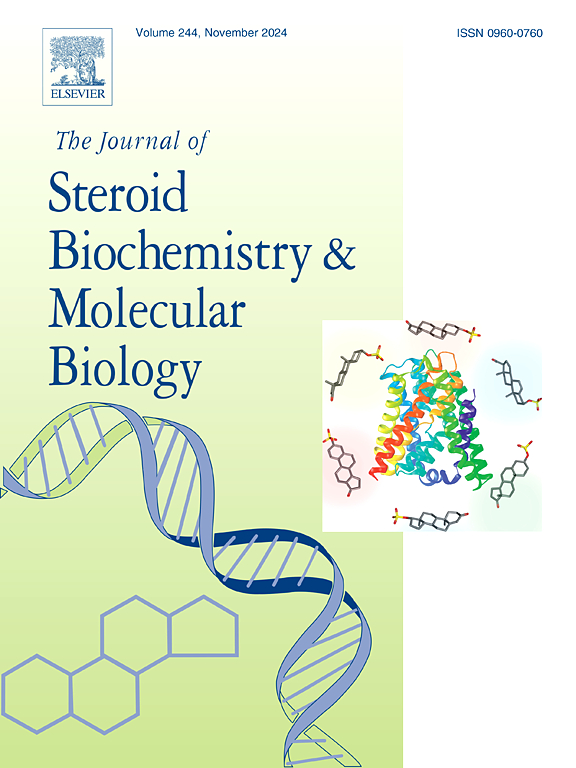POMC mediates orofacial hyperalgesia under hypoestrogenic conditions
IF 2.5
2区 生物学
Q3 BIOCHEMISTRY & MOLECULAR BIOLOGY
Journal of Steroid Biochemistry and Molecular Biology
Pub Date : 2025-09-12
DOI:10.1016/j.jsbmb.2025.106861
引用次数: 0
Abstract
Estrogen modulates sensory neuron excitability via metabolic pathways, regulating women's pain perception. pro-opiomelanocortin (POMC), an endogenous polypeptide precursor, regulates pain response and is highly expressed in the trigeminal ganglion (TG). In this study, we used ovariectomized female rats to study how trigeminal ganglion POMC links to orofacial allodynia in hypoestrogenic state, and verified at both the gene and protein levels that the expression of POMC in the trigeminal ganglion decreased under the hypoestrogenic state. Subsequently, overexpressing the POMC gene in the TG reversed the pain hyperalgesia in ovariectomized rats. To further explore the regulatory mechanism of estrogen on POMC, we injected a selective estrogen receptor agonist at the trigeminal ganglion. Estradiol (E2) in the TG regulates the expression of POMC through estrogen receptor α (ERα). Subsequently, the Chromatin Cleavage and Tagging technology (CUT&Tag) and the dual-luciferase assay revealed that estrogen receptor α in the trigeminal ganglion has a positive regulatory effect on the promoter of POMC. In conclusion, this study has found that in the trigeminal ganglion, estrogen receptor α may reduce the expression of the POMC gene by inhibiting the activity of the POMC promoter. Meanwhile, this study has also found that in the TG, ERα may further regulate the biological activity of the POMC protein by binding to it. This dual regulation at both the transcriptional level and the protein level collectively mediates a decrease in the orofacial mechanical pain threshold and triggers an orofacial allodynia response.
POMC介导低雌激素条件下的口面部痛觉过敏。
雌激素通过代谢途径调节感觉神经元的兴奋性,调节女性的疼痛感知。opiomelanocortin (POMC)是一种内源性多肽前体,调节疼痛反应,并在三叉神经节(TG)中高度表达。在本研究中,我们利用去卵巢的雌性大鼠研究了低雌激素状态下三叉神经节POMC与口面异痛症的联系,并在基因和蛋白水平上证实了低雌激素状态下三叉神经节POMC的表达减少。随后,在TG中过表达POMC基因逆转了去卵巢大鼠的痛觉过敏。为了进一步探讨雌激素对POMC的调控机制,我们在三叉神经节处注射选择性雌激素受体激动剂。甘油三酯中的雌二醇(E2)通过雌激素受体α (ERα)调节POMC的表达。随后,染色质切割和标记技术(CUT&Tag)和双荧光素酶实验发现三叉神经节雌激素受体α对POMC启动子具有正调控作用。综上所述,本研究发现,在三叉神经节中,雌激素受体α可能通过抑制POMC启动子的活性来降低POMC基因的表达。同时,本研究还发现,在TG中,ERα可能通过与POMC蛋白结合,进一步调节POMC蛋白的生物活性。这种转录水平和蛋白质水平的双重调控共同介导了口面机械痛阈的降低,并引发了口面异常性痛反应。
本文章由计算机程序翻译,如有差异,请以英文原文为准。
求助全文
约1分钟内获得全文
求助全文
来源期刊
CiteScore
8.60
自引率
2.40%
发文量
113
审稿时长
46 days
期刊介绍:
The Journal of Steroid Biochemistry and Molecular Biology is devoted to new experimental and theoretical developments in areas related to steroids including vitamin D, lipids and their metabolomics. The Journal publishes a variety of contributions, including original articles, general and focused reviews, and rapid communications (brief articles of particular interest and clear novelty). Selected cutting-edge topics will be addressed in Special Issues managed by Guest Editors. Special Issues will contain both commissioned reviews and original research papers to provide comprehensive coverage of specific topics, and all submissions will undergo rigorous peer-review prior to publication.

 求助内容:
求助内容: 应助结果提醒方式:
应助结果提醒方式:


